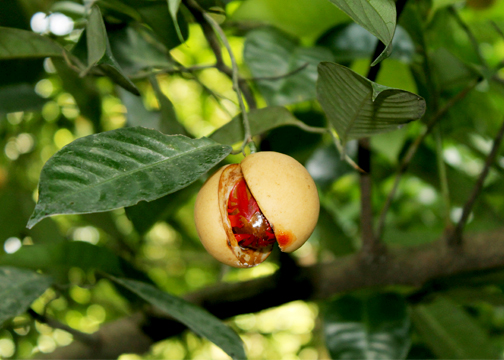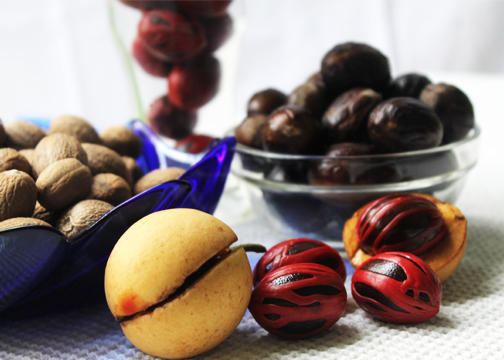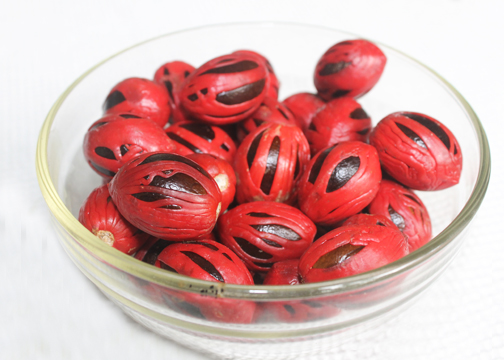


Nutmeg & Mace
Nutmeg trees may reach a height of about 20 meters (65 feet). nutmeg starts to bear at the 7th year and harvest increases with time and reach their prime in 20 years.
Nutmeg is the actual seed of the tree, roughly egg-shaped and about 20 to 30 mm (0.8 to 1 in) long and 15 to 18 mm (0.6 to 0.7 in) wide, and weighing between 5 and 10 g (0.2 and 0.4 oz) dried, while mace is the dried "lacy" reddish covering or aril of the seed.
The yield of nutmeg varies from tree to tree from several nuts to 8000-10000 nuts per tree. Average yield is 1500dry nutmeg/tree/year and 1-1.5kgdry mace/tree/year.
In Sri Lanka, no specific varieties have been identified. Mother trees are selected considering high yield. (over 10,000fruits/tree/yr), regular bearing habit, weight of wet whole nut 30g, size of the nut (wet weight 10g /fruit) and heavy mace (wet weight 1g/fruit). Grafting and air layering both can be successfully done. They can produce fruit bearing female trees.
Major growing areas in SL
Nutmeg prefers cooler climates hence mid country areas of Sri Lanka are ideal for the growth of nutmeg. The total extent of Nutmeg in Sri Lanka is 2788ha and from which 80% of the extent is in Kandy district. Other major growing areas are Kegalle and Matale districts.
Processing
As soon as fruits split or about to split, they are hand-picked from the trees. Fruits are opened by hand and the mace is removed from the nut by cutting with a small pointed knife where it is attached to the base of the nut. The nuts are dried until the kernel rattles in the shell. Dried nutmeg can be sold as it is or can be shelled and sold only the kernel. The mace is flattened by hand and dried slowly under the sun.
Usage & importance
Nutmeg and mace are the main two products. Oils are extracted from both nutmeg and mace. Powdered nutmeg and mace are used in curry powders. Nutmeg and mace are mainly used for culinary purposes to flavor curries and other food products, confectionaries and bakery products. It is also used in the preparation of beverages and drinks.
The essential oil is obtained by steam distillation of ground nutmeg and is used widely in the perfumery and pharmaceutical industries. The oil is colorless or light yellow, and smells and tastes of nutmeg. It is used to replace ground nutmeg, as it leaves no particles in the food. The essential oil is also used in the cosmetic and pharmaceutical industries, for instance, in toothpaste, and as a major ingredient in some cough syrups. In traditional medicine, nutmeg and nutmeg oil were used for disorders related to the nervous and digestive systems.
Nutmeg butter is obtained from the nut by expression. It is semi-solid, reddish brown in colour, and tastes and smells of nutmeg. Approximately 75% (by weight) of nutmeg butter is trimyristin, which can be turned into myristic acid, a 14 carbon fatty acid, which can be used as a replacement for cocoa butter, can be mixed with other fats like cottonseed oil or palm oil, and has applications as an industrial lubricant.

